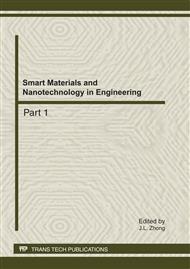[1]
C. Tong, X. Zhuo, W. Liu and J. Wu. Ueda, Synchronous fluorescence measurement of enrofloxacin in the pharmaceutical formulation and its residue in milks based on the yttrium (III)-perturbed luminescence. Talanta, 2010, 82(5): 1858-1863.
DOI: 10.1016/j.talanta.2010.07.082
Google Scholar
[2]
H. Yan, H. Wang, X. Qin, B. Liu and J. Du, Ultrasound-assisted dispersive liquid–liquid microextraction for determination of fluoroquinolones in pharmaceutical wastewater. J Pharm Biomed Anal, 2011, 54(1): 53-57.
DOI: 10.1016/j.jpba.2010.08.007
Google Scholar
[3]
S. Zhao, H. Jiang, X. Li, T. Mi, C. Li and J. Shen, Simultaneous determination of trace levels of 10 quinolones in swine, chicken, and shrimp muscle tissues using HPLC with programmable fluorescence detection. J Agric Food Chem, 2007, 55(10): 3829-3834.
DOI: 10.1021/jf0635309
Google Scholar
[4]
E. A. Christodoulou, F. V. Samanidou and I. N. Papadoyannis, Development of an HPLC multi-residue method for the determination of ten quinolones in bovine liver and porcine kidney according to the European Union Decision 2002/657/EC. J Sep Sci, 2008, 31(1): 119-127.
DOI: 10.1002/jssc.200700297
Google Scholar
[5]
B. Delepine, D. Hurtaud-Pessel and P. Sanders, Simultaneous determination of six quinolones in pig muscle by liquid chromatography-atmospheric pressure chemical ionization mass spectrometry. Analyst, 1998, 123(12): 2743-2747.
DOI: 10.1039/a804911d
Google Scholar
[6]
B. San Martín, J. Cornejo, D. Iragüen, H. Hidalgo and A. Anadón, Depletion study of enrofloxacin and its metabolite ciprofloxacin in edible tissues and feathers of white leghorn hens by liquid chromatography coupled with tandem mass spectrometry. J Food Prot, 2007, 70(8): 1952-(1957).
DOI: 10.4315/0362-028x-70.8.1952
Google Scholar
[7]
G. Dufresne, A. Fouquet, D. Forsyth and S. A. Tittlemier, Multiresidue determination of quinolone and fluoroquinolone antibiotics in fish and shrimp by liquid chromatography/tandem mass spectrometry. J AOAC Int, 2007, 90(2): 604-612.
DOI: 10.1093/jaoac/90.2.604
Google Scholar
[8]
M. P. Hermo, E. Nemutlu, S. Kir, D. Barrón and J. Barbosa, Improved determination of quinolones in milk at their MRL levels using LC-UV, LC-FD, LC-MS and LC-MS/MS and validation in line with regulation 2002/657/EC. Anal Chim Acta, 2008, 613(1): 98-107.
DOI: 10.1016/j.aca.2008.02.045
Google Scholar
[9]
H. Watanabe, A. Satake, Y. Kido and A. Tsuji, Monoclonal-based enzyme-linked immunosorbent assays and immunochromatographic assay for enrofloxacin in biological matrices. Analyst, 2002, 127(1): 98-103.
DOI: 10.1039/b109427k
Google Scholar
[10]
Z. Wang, Y. Zhu, S. Ding, F. He, R. Beier, et al., Development of a monoclonal antibody-based broad-specificity ELISA for fluoroquinolone antibiotics in foods and molecular modeling studies of cross-reactive compounds. Anal Chem, 2007, 79(12): 4471-4483.
DOI: 10.1021/ac070064t
Google Scholar
[11]
S. Bucknall, J. Silverlight, N. Coldham, L. Thorne and R. Jackman, Antibodies to the quinolones and fluoroquinolones for the development of generic and specific immunoassays for detection of these residues in animal products. Food Addit Contam, 2003, 20(3): 221-228.
DOI: 10.1080/0265203021000055388
Google Scholar
[12]
Y. Zhao, G. Zhang, Q. Liu, M. teng, J. Yang and J. Wang, Development of a Lateral Flow Colloidal Gold Immunoassay Strip for the Rapid Detection of Enrofloxacin Residues. J Agric Food Chem, 2008, 56(24): 12318-12142.
DOI: 10.1021/jf802648z
Google Scholar
[13]
B. Huang, Y. Yin, L. Lu, H. Ding, L. Wang, T. Yu, et al., Preparation of high-affinity rabbit monoclonal antibodies for ciprofloxacin and development of an indirect competitive ELISA for residues in milk. J Zhejiang Uni-Sci B (Biomed & Biotechnol), 2010, 11(10): 812-818.
DOI: 10.1631/jzus.b1000055
Google Scholar
[14]
X. L. Hao, H. Kuang, Y. L. Li, Y. Yuan, C. F. Peng, W. Chen, et al., Development of an enzyme-linked immunosorbent assay for the alpha-cyano pyrethroids multiresidue in Tai lake water. J Agric Food Chem, 2009, 57(8): 3033-3039.
DOI: 10.1021/jf803807b
Google Scholar
[15]
J. Jiang, H. Zhang, G. Li, Z. Wang, J. Wang and H. Zhao., Preparation of anti-nortestosterone antibodies and development of an indirect heterologous competitive enzyme-Linked immunosorbent assay to detect nortestosterone residues in animal urine. Analytical letters, in press.
DOI: 10.1080/00032719.2010.551694
Google Scholar


